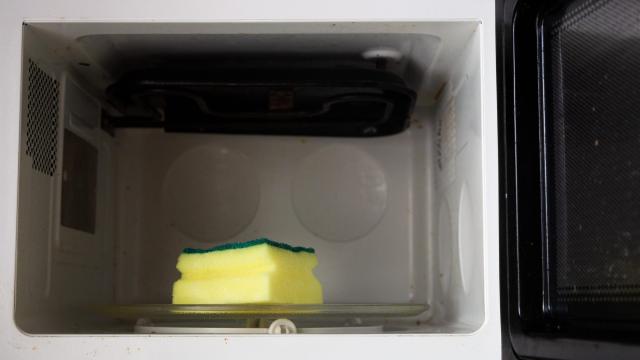Let’s just start here: Kitchen sponges are disgusting. A 2017 study published in Nature.com’s Scientific Reports found that used kitchen sponges harbored a whopping 362 different types of bacteria, in a staggering density of 45 billion microbes per square centimeter. According to the report, kitchen environments host more microbes than toilets, “mainly due to the contribution of kitchen sponges, which were proven to represent the biggest reservoirs of active bacteria in the whole house.” More than toilets? Yikes.
So what can you do to limit spreading these nasty bacteria all over our dishes and kitchen counters — besides throwing out your sponge every week? Some say: microwave them. The idea isn’t new, and it has faced scepticism. The New York Times reported that while microwaving may kill the weak bacteria, “the strongest, smelliest, and potentially pathogenic bacteria will survive.”
But Michaeleen Doucleff — whose research while earning a doctoral degree in chemistry included growing, studying, and killing bacteria — wasn’t convinced. Doucleff wrote for NPR that the sponge bacteria to be most concerned about — the food-borne pathogens — are “weaklings” that once heated even just a little bit, “literally pop.”
Even the authors of the sponge study themselves said, “Sanitation by boiling or microwave treatment has been shown to significantly reduce the bacterial load of kitchen sponges and can therefore be regarded as a reasonable hygiene measure.” But they then said, in the next sentence: “However, our data showed that regularly sanitised sponges (as indicated by their users) did not contain less bacteria than uncleaned ones.” Huh?
Upon taking a deep dive into the original sponge study, food microbiologist Jennifer Quinlan told NPR “there was no clear explanation of what ‘regular cleaning’ meant” and that “the study stated that the sponges were either microwaved or put in hot, soapy water.” The latter method, Quinlan said, “could actually encourage the bacteria.” (Did we mention the study looked at only five sponges that people reported “cleaning regularly” in Germany?)
Enter the U.S. Department of Agriculture. According to the USDA, both microwaving and dishwashing sponges kills 99.9% of bacteria. (The sponges tested had been soaked in none other than ground beef juice. Yuck.)
So, who’s right? While microwaving your sponges is not a failsafe, longterm solution, it can definitely zap a good number of harmful bacteria and increase the lifespan of your sponge. So, basically? Don’t do it forever. Recognise that the sponge will still harbour some bacteria after nuking, and it will need to be tossed eventually. When, exactly, is up to your own tolerance for invisible microbes.
How to microwave your sponge:
1) Make sure it doesn’t have a metallic scrub pad. Those should be cleaned in your dishwasher on high heat, including a heated dry cycle.
2) Get it completely wet. Dry sponges can catch fire in the microwave.
3) Zap it on full power for one minute.
4) Let it sit in microwave for five to ten minutes to cool down before removing.
A few more sponge health tips: Don’t use them to clean up raw meat juices; use paper towel instead. Clean them regularly (every few days or once a week). And don’t wait too long before you toss them. A good rule of thumb is about once a month.

Leave a Reply
You must be logged in to post a comment.